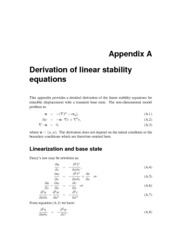| dc.contributor.author | Elenius, Maria | eng |
| dc.date.accessioned | 2012-02-01T12:30:17Z | |
| dc.date.available | 2012-02-01T12:30:17Z | |
| dc.date.issued | 2011-11-25 | eng |
| dc.identifier.isbn | 978-82-308-1890-9 (print version) | en_US |
| dc.identifier.uri | https://hdl.handle.net/1956/5540 | |
| dc.description.abstract | The industrial era has seen an exponential growth in the atmospheric concentration of carbon dioxide (CO2), resulting mainly from the burning of fossil fuels. This can cause changes in the climate that have severe impacts on freshwater and food supply, ecosystems and society. One of the most viable options to reduce CO2 emissions is to store it in geological formations, in particular in saline aquifers. In this option, the carbon is again stored in the subsurface, from which it was extracted. The first geological storage project was initiated in Norway, in 1996, and CO2 has long before been injected to geological formations to enhance oil recovery. Storage occurs with CO2 in a so-called supercritical state and this fluid is buoyant in the formation. Four physical mechanisms help trapping the carbon in the formation: the CO2 plume accumulates under a low-permeability caprock; CO2 is trapped as disconnected drops in small pores; buoyancy is lost when CO2 dissolves into the water; and on longer time-scales chemical reactions incorporate the carbon in minerals. Dissolution trapping is largely determined by convective mixing, which is a rich problem that was first investigated almost 100 years ago. We investigate the influence of convective mixing on dissolution trapping in geological storage of CO2. Most formations that can be used for CO2 storage are slightly tilted. We show with numerical simulations that dissolution trapping must in general be acknowledged when questions about the final migration distance and time of the CO2 plume are to be answered. The saturations in the plume correspond well to transition zones consistent with capillary equilibrium. The results also show that the capillary transition zone, in which both the supercritical CO2 plume and the water phase exist and are mobile, participates in the convective mixing. Using linear stability analysis complemented with numerical simulations, we show that the interaction between convective mixing and the capillary transition zone leads to considerably larger dissolution rates and a reduced onset time for enhanced convective mixing compared to when this interaction is neglected. The selection of the wavelength that first becomes unstable remains almost unchanged by the interaction. A statistical investigation of the onset time of enhanced convective mixing under the neglection of the capillary transition zone reveals that it is notably larger than the onset time of instability for three example formations. However, comparison of these simulation results with the investigations in a sloping aquifer preliminarily suggest that the distance that the plume propagates during the onset time of enhanced convective mixing is negligible and that therefore this time can be assumed to be zero, with the possible exception of aquifers that have steep slopes. | en_US |
| dc.language.iso | eng | eng |
| dc.publisher | The University of Bergen | en_US |
| dc.relation.haspart | Paper I: Elenius, Maria T., Tchelepi, Hamdi A., Johannsen, Klaus. Co2 trapping in sloping aquafiers: High resolution numerical simulations. In Proceedings of XVIII International Conference on Water Resources, 2010. The article is available at: <a href="http://hdl.handle.net/1956/5539" target="blank">http://hdl.handle.net/1956/5539</a> | en_US |
| dc.relation.haspart | Paper II: Elenius, Maria T., Nordbotten, J. M., and Kalisch, H. Effects of a capillary transition zone on the stability of a diffusive boundary layer. Full-text not available in BORA. | en_US |
| dc.relation.haspart | Paper III: Elenius, Maria T., Johannsen, Klaus. On the time scales of nonlinear instability in miscible displacement porous media flow. Full-text not available in BORA. | en_US |
| dc.title | Convective mixing in geological carbon storage | en_US |
| dc.type | Doctoral thesis | |
| dc.rights.holder | Copyright the author. All rights reserved | en_US |
| dc.subject.nsi | VDP::Mathematics and natural science: 400::Geosciences: 450 | en_US |
| dc.subject.nsi | VDP::Mathematics and natural science: 400::Mathematics: 410::Applied mathematics: 413 | en_US |

